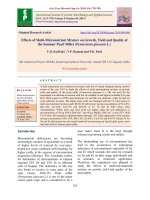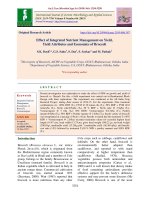Effect of integrated weed management on yield, yield attributes and economics of pearl millet [Pennisetum glaucum (L.) R. Br. Emend stuntz]
Bạn đang xem bản rút gọn của tài liệu. Xem và tải ngay bản đầy đủ của tài liệu tại đây (124 KB, 5 trang )
��������������������������������������������������������������������������������������������������������������������������������������������������������������������������������������������������������������������������������������������������������������������������������������������������������������������������������������������������������������������������������������������������������������������������������������������������������������������������������������������������������������������������������������������������������������������������������������������������������������������������������������������������������������������������������������������������������������������������������������������������������������������������������������������������������������������������������������������������������������������������������������������������������������������������������������������������������������������������������������������������������������������������������������������������������������������������������������������������������������������������������������������������������������������������������������������������������������������������������������������������������������������������������������������������������������������������������������������������������������������������������������������������������������������������������������������������������������������������������������������������������������������������������������������������������������������������������������������������������������������������������������������������������������������������������������������������������������������������������������������������������������������������������������������������������������������������������������������������������������������������������������������������������������������������������������������������������������������������������������������������������������������������������������������������������������������������������������������������������������������������������������������������������������������������������������������������������������������������������������������������������������������������������������������������������������������������������������������������������������������������������������������������������������������������������������������������������������������������������������������������������������������������������������������������������������������������������������������������������������������������������������������������������������������������������������������������������������������������������������������������������������������������������������������������������������������������������������������������������������������������������������������������������������������������������������������������������������������������������������������������������������������������������������������������������������������������������������������������������������������������������������������������������������������������������������������������������������������������������������������������������������������������������������������������������������������������������������������������������������������������������������������������������������������������������������������������������������������������������������������������������������������������������������������������������������������������������������������������������������������������������������������������������������������������������������������������������������������������������������������������������������������������������������������������������������������������������������������������������������������������������������������������������������������������������������������������������������������������������������������������������������������������������������������������������������������������������������������������������������������������������������������������������������������������������������������������������������������������������������������������������������������������������������������������������������������������������������������������������������������������������������������������������������������������������������������������������������������������������������������������������������������������������������������������������������������������������������������������������������������������������������������������������������������������������������������������������������������������������������������������������������������������������������������������������������������������������������������������������������������������������������������������������������������������������������������������������������������������������������������������������������������������������������������������������������������������������������������������������������������������������������������������������������������������������������������������������������������������������������������������������������������������������������������������������������������������������������������������������������������������������������������������������������������������������������������������������������������������������������������������������������������������������������������������������������������������������������������������������������������������������������������������������������������������������������������������������������������������������������������������������������������������������������������������������������������������������������������������������������������������������������������������������������������������������������������������������������������������������������������������������������������������������������������������������������������������������������������������������������������������������������������������������������������������������������������������������������������������������������������������������������������������������������������������������������������������������������������������������������������������������������������������������������������������������������������������������������������������������������������������������������������������������������������������������������������������������������������������������������������������������������������������������������������������������������������������������������������������������������������������������������������������������������������������������������������������������������������������������������������������������������������������������������������������������������������������������������������������������������������������������������������������������������������������������������������������������������������������������������������������������������������������������������������������������������������������������������������������������������������������������������������������������������������������������������������������������������������������������������������������������������������������������������������������������������������������������������������������������������������������������������������������������������������������������������������������������������������������������������������������������������������������������������������������������������������������������������������������������������������������������������������������������������������������������������������������������������������������������������������������������������������������������������������������������������������������������������������������������������������������������������������������������������������������������������������������������������������������������������������������������������������������������������������������������������������������������������������������������������������������������������������������������������������������������������������������������������������������������������������������������������������������������������������������������������������������������������������������������������������������������������������������������36
3212
Return
Grain
Stover
13808
9926
24416
13496
31792
17272
16576
11242
1339
3516
21424
1641
1976
4325
4898
1156
1456
Gross
returns
23734
37912
49064
27818
Net returns
BCR
2717
13520
21297
5026
1.12
1.55
1.76
1.22
12306
33730
7563
1.28
26256
31616
15137
17143
41393
48759
19341
23332
1.87
1.91
3189
18496
11161
29657
7785
1.35
3456
23296
12096
35392
10145
1.40
2631
Int.J.Curr.Microbiol.App.Sci (2019) 8(10): 2629-2633
It is clear from the results that all the IWM
treatments evaluated in present study varied
widely in their effect on yield attributing
characters like length of ear head, test weight,
grain, stover and biological yields were found
significantly superior in comparison to control
treatment. The maximum test weight (8.43 g)
was recorded under the treatment T2 (2 HW at
20 and 40 DAS). This result might be due to
the fact that increased uptake of nutrients due
to weed free environment and as a result there
was more growth and development and
thereby resulted in higher test weight (Singh
et al. 2001). The highest ear head length was
observed under Atrazine @ 750 g ha-1 (PE) +
1 HW at 20 DAS (T6). Two HW at 20 and 40
DAS (T2) recorded grain and stover yield
(1,339 and 3,516 kg ha-1, respectively) kept
the crop almost weed free environment which
in turn resulted in significant reduction in
competition for nutrients and other growth
resources by weeds (Vanaja. 2007), Srividhya
et al. (2011), Sandhyarani and Karunasagar
(2013) and Sunitha et al. (2011). Furthermore,
the most severe competition throughout the
crop season due to unrestricted weed growth
under Control (T0) plots increased the
depletion and moisture by weeds, thus
adversely affecting the crop growth and
ultimately resulted in the lowest yield of crop
(Kaur and Singh. 2006), Kiroriwal et al.
(2012) and Munde et al. (2013) in pearl
millet.
All the integrated weed control treatments
provided significantly higher net returns and
B: C ratio in comparison to control. Atrazine
@ 750 g ha-1 (PE) + 1 HW at 20 DAS (T6)
treatment fetched the maximum net returns (
23332 ha-1) with a BCR of 1.91. The higher
net returns under superior treatment was the
result of higher grain and stover yield due to
effective control of weeds. The lowest grain
yield achieved under control (T0) treatment
was eventually reflected in the lowest net
returns ( 2717 ha-1) and B: C ratio (1.12).
Results of the present investigation
corroborate with the findings of Arvadiya et
al. (2012), Mathukia et al. (2015) and Mishra
et al. (2017) in pearl millet.
References
Anonymous, (2018).Indian Economy Survey,
Area, Production and Yield of major
crops. Govt of India, Ministry of
finance, economic division, New Delhi.
Arvadiya, L. K., Raj, V. C., Patel, T. U. and
Arvadiya, M. K. (2012). Influences of
plant population and weed management
on weed flora and productivity of sweet
corn (Zea mays). Indian Journal of
Agronomy, 57(2): 162-167.
Das, T. K. and Yaduraju, N.T. (1995).Crop
weed competition studies in some kharif
crops: 11, nutrient uptake and yield
reduction. Annals of Plant Protection
Science, 3(2): 95-99.
Kaur, A. and Singh, V.P. (2006). Weed
dynamics as influenced by planting
methods, mulching and weed control in
rainfed hybrid pearl millet (Pennisetum
glaucum).
Indian
Journal
of
WeedScience, 38(1&2): 135-136.
Kiroriwal, A., Yadav, R.S. and Kumawat, A.
(2012). Weed management in pearl
millet based intercropping system.
Indian Journal of Weed Science, 44(3):
200–203.
Mathukia, R.K., Mathukia, P.R. and Polara,
A.M. (2015). Intercropping and weed
management in pearl millet (Pennisetum
glaucum) under rainfed condition.
Agriculture ScienceDigest, 35(2): 138141.
Mishra, P. S., Ramu Reddi, Y.,
Subramanyam, D. and Umamahesh,
V.(2017).Impact of integrated weed
management practices on weed
dynamics, growth and yield of Pearl
millet [Pennisetum glaucum(L). R. Br.
Emend Stuntz] of International journal
2632
Int.J.Curr.Microbiol.App.Sci (2019) 8(10): 2629-2633
of Agriculture sciences, 9(3): 36773678.
Munde, S.D., Patel, J.C., Ali, S. and Aghav,
V.D. (2013). Weed control study in
kharif
pearl
millet
(Pennisetum
glaucum). Bioinfolet, 10(2A): 464-468.
Sandhyarani, B. and Karunasagar, G. (2013).
Effect of integrated weed management
on growth, yield and economics of
sweet corn.Agriculture Science Digest.
33(1): 52-55.
Singh, R. K., Chauhan, S. P. S. and Singh, S.
(2001). Integrated weed management in
pearl millet (Pennisetum typhoides).
Indian
Journal
of
Weed
Science,33(3&4): 206-208.
Srividhya, S., Chandrasekhar, K. and
Veeraraghavaiah.(2011).
Effect
of
tillage and herbicide use on weed
management in maize (Zea mays L.).
Andhra Agriculture Journal, 58(2):
123-125.
Sunitha, N., Maheswara Reddy, P. and
Reddy, D. S. (2011). Influence of
planting pattern and weed control
practices on weed growth, nutritive
uptake and productivity of sweet corn.
CropResearch.41(1,2&3): 13-20.
Vanaja, C. H. (2007). Weed management
studies in kharif maize. M. Sc.
(Agriculture) Thesis submitted to
Acharya N. G. Ranga Agricultural
University Rajendranagar, Hyderabad.
How to cite this article:
Yalamati Sree Ram Kumar, Rabindra Kumar, Yasin Abrar Baba and Samruthi, M. 2019. Effect
of Integrated Weed Management on Yield, Yield Attributes and Economics of Pearl Millet
[Pennisetum glaucum (L.) R. Br. Emend stuntz]. Int.J.Curr.Microbiol.App.Sci. 8(10): 26292633. doi: />
2633




![Genetic analysis for micronutrients and grain yield in relation to diverse sources of cytoplasm in pearl millet [Pennisetum glaucum (L.) R. Br.]](https://media.store123doc.com/images/document/2020_01/13/medium_ion1578932058.jpg)
![Response of pearl millet [Pennisetum glaucum L. (R. Br.)] to integrated nitrogen management](https://media.store123doc.com/images/document/2020_01/14/medium_jyr1578949761.jpg)
![Production of interspecific hybrids between pearl millet [Pennisetum glaucum (L.) R. Br.] × Napier Grass [Pennisetum purpureum (K.) Schum] and their characterization](https://media.store123doc.com/images/document/2020_01/14/medium_rod1578988436.jpg)


